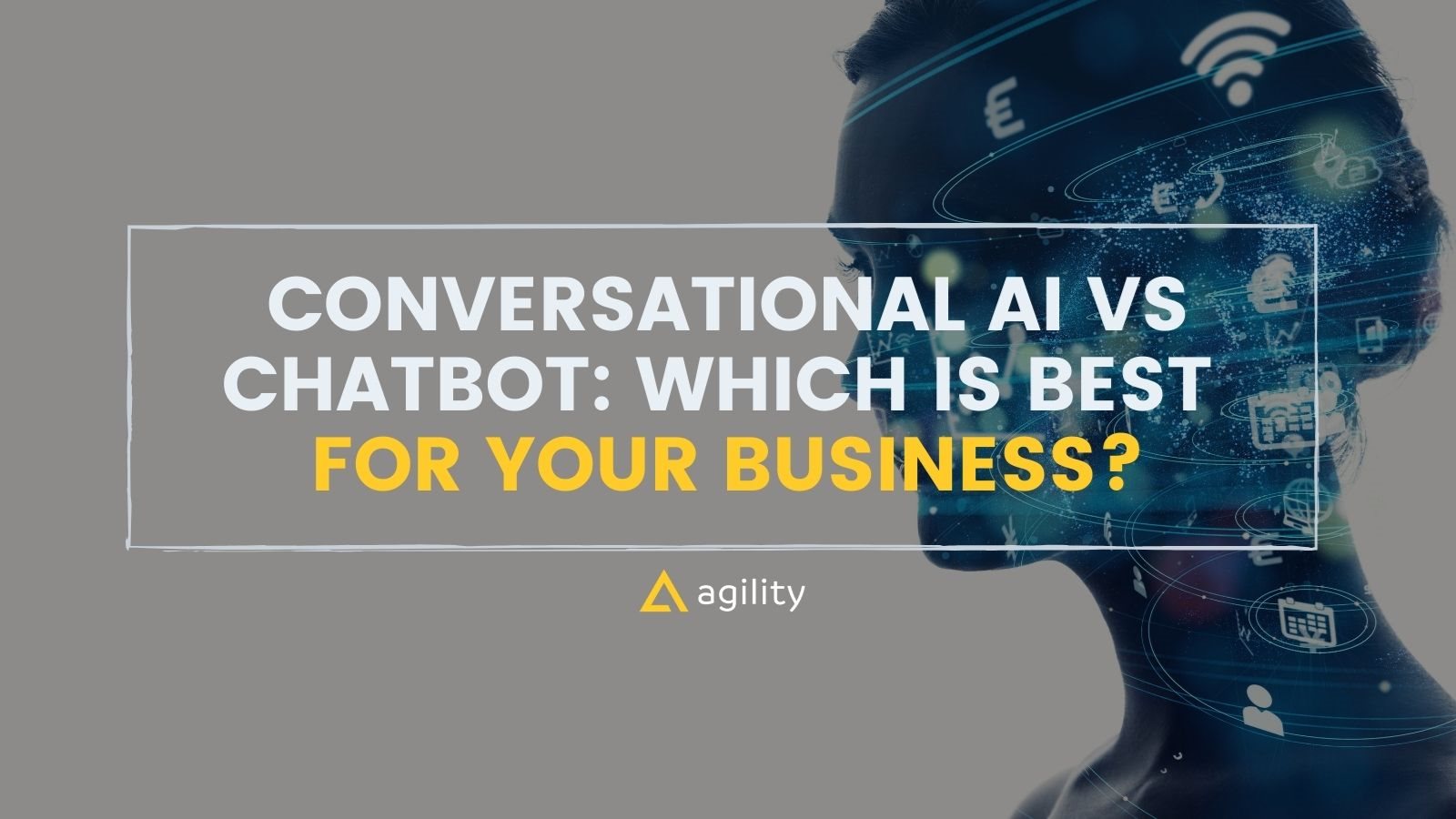Conversational AI is a big business these days - according to recent research, the global conversational AI market size will hit $13.9 billion in 2025. It is becoming an increasingly present feature of modern-day business. But all the buzz means that terms such as chatbot and conversational AI get thrown around interchangeably. Let’s take a look at conversational AI vs chatbots, what sets them apart, and above all which will make the biggest difference to your business.
Conversational AI vs Chatbot: what are the main differences?

Let’s start by taking a quick look at chatbots. Chatbots have been a focus of research for a few decades now, and while early efforts were less than satisfactory, recent advances have made chatbots a true asset to the workplace. Industries including; healthcare, education, transport, telecommunications, and finance are profiting from chatbots’ ability to reduce wait times, improve cost efficiency, boost productivity and generally relieve human agents of time-consuming, routine tasks. But did you know that there are actually several different types of chatbots?
Rule-based and AI-enhanced chatbots
The simplest and most widespread are known as rule-based chatbots. These chatbots, which offer pre-programmed answers triggered by particular keywords, are great when it comes to responding to simple queries. Rule-based chatbots have become increasingly popular since the launch of the Facebook Messenger platform, which enables businesses to automate certain aspects of their customer support through chatbots.
AI-based chatbots, on the other hand, are more sophisticated and use features from conversational AI, such as NLP (or Natural Language Processing), to interpret and respond to human language. These chatbots can respond to more complex queries without the input of a human customer service agent. What’s more, they can integrate via APIs with back-end systems and actually perform tasks for the user rather than just provide them with instructions about how to do it themselves.
All about conversational AI

So what is conversational AI? Conversational AI is the actual set of technologies and machine learning algorithms that mimic human conversation. It is used to obtain relevant information from a user, understand their intent, and respond in a way that sounds natural. Conversational AI is not only reserved for chatbots: it is also used for voice-controlled devices such as smart speakers and call bots. The ultimate aim of conversational AI is to offer conversational experiences that are indistinguishable from those you would have with a human.
How does conversational AI work?

Conversational AI is an exciting subset of AI, one that is based on advanced scientific and linguistic research. Successful applications require considerable fine-tuning in order to integrate context, customization and relevance into exchanges between humans and computers. But how does conversational AI actually work?
Chatbots based on conversational AI use various technologies, which include NLP, dialog management, and machine learning (ML). First of all, the application receives input in the form of a written query from the user, such as “Help, I can’t remember my username”. The application has to decipher what the user actually means and the intent behind their query. For this, it uses Natural Language Understanding (or NLU), a subset of NLP that enables machines to gauge intent and convert it into structured data that they can interpret. Based on its understanding of the intent behind the query, the application then forms a response using dialog management. The role of the dialog manager is to orchestrate responses and create a conversational flow, taking into account variables such as the conversation history and previous questions. Finally, the response is converted into language understandable to human beings by using Natural Language Generation (or NLG), another subdomain of NLP.
When it comes to voice-controlled applications, such as Alexa or Siri, two further technologies come into play. Automatic Speech Recognition (ASR) enables users to speak directly to devices, turning their words into text. TTS, or Text-To-Speech, does the opposite, by converting text into spoken sound.
Which is best for your business?

Bots are revolutionizing the way we do business. But when it comes to conversational AI vs. chatbots, which is best for your company? To be honest, there’s no hard and fast answer. The answer will depend significantly on your needs and your use case.
AI-driven content recommendations will significantly improve your click-through rates up to X5 times and eventually conversion rates up to 50% among visitors who saw personalized content.
When you ask businesses their main reason for implementing a chatbot, the answer is generally something along the lines of improving efficiency and offering customers a faster, more satisfactory experience that gets their issues solved as soon as possible. Those businesses are on the right track: according to recent research, quality of customer service is a key factor for 84% of consumers. With customer experience a key differentiator in an increasingly competitive landscape, the business value of being able to get back to a customer in 1 minute instead of 45 is undeniable. What’s more, today’s sophisticated AI-based chatbots are able to do so much more than just point customers in the right direction. The Estonian telco company Elisa Estonia, for example, found that their AI chatbot was able to handle over two-thirds of billing queries without human intervention.
When should your business implement conversational AI applications?
As we mentioned above, the aim of conversational AI applications is to provide natural conversational experiences that give the user the impression that they’re talking to a real human being. Conversational AI is indeed fascinating from a scientific and linguistic perspective, and there’s no telling what we will be able to achieve with it in a few years’ time. At this point, however, our research indicates that for maximal business value, conversational AI should only be implemented once other issues in the customer journey have been resolved. As you can see below, AI-based chatbots tend to provide more value and faster results.
Fully conversational AI may enable bots to flawlessly mimic human conversation, but the ultimate impact of this on everyday business operations is limited. Businesses need to keep in mind that the most important aspect from a customer’s point of view is the swift resolution of their issues, not a friendly chat. As we discussed above, AI-based chatbots are able to handle queries without human input, perform tasks for users and solve problems quickly and efficiently. This is where their true business value lies.
However, you might have reached the stage where you think conversational AI could be an interesting addition to your customer experience. The team at MindTitan has experience implementing conversational AI and would be happy to discuss your specific use case in order to identify the best options for your company.
Conclusion
So when it comes down to it, what’s the difference between conversational AI vs. chatbots? As we discussed above, chatbots simulate human exchange through interfaces such as the messaging platforms we use every day, while conversational AI is a set of technologies that aim to simulate human conversation in a way that feels as natural as possible. Before deciding what kind of chatbot to implement, it’s essential to carefully consider your use case and what your new addition will bring to your business. MindTitan is on hand to help you make the right decision as we have experience implementing various kinds of chatbots.
Learn more:
AI In E-commerce: How It Is Changing The Industry | Agility CMS
What is headless commerce? Cost effective omnichannel sites. (agilitycms.com)
Composable DXP: Headless CMS + Personalization (agilitycms.com)



